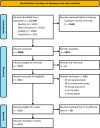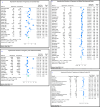Hypertensive disorders of pregnancy and childhood neurodevelopment: A systematic review and meta-analysis
- PMID: 40929171
- PMCID: PMC12422451
- DOI: 10.1371/journal.pmed.1004558
Hypertensive disorders of pregnancy and childhood neurodevelopment: A systematic review and meta-analysis
Abstract
Background: Hypertensive disorders of pregnancy may be associated with an increased risk of adverse neurodevelopmental outcomes for the child, though no recent comprehensive meta-analyses exist. The aim of this study was to conduct a systematic review and meta-analysis examining the association between hypertensive disorders of pregnancy and child neurodevelopmental disabilities, intelligence, and educational outcomes.
Methods and findings: A search was conducted of MEDLINE, CINAHL, Web of Science, and PsycINFO databases from inception until 18 September 2024. Reference lists of included papers were also screened. Observational studies and secondary analyses of randomized trials reporting neurodevelopmental, cognitive, or educational outcomes for children born following hypertensive disorders of pregnancy against a reference population (unaffected pregnancies) were included. Two reviewers independently screened records, extracted data, and assessed quality of studies using Preferred Reporting Items for Systematic Reviews and Meta-Analyses. Studies reporting similar outcomes were pooled using a random-effects meta-analysis model. Outcomes included autism, attention-deficit/hyperactivity disorder, cerebral palsy, global developmental delay, intellectual disability, intelligence quotient, and educational attainment. Results were reported as odds ratios (OR) or mean difference (MD) with corresponding 95% confidence intervals (CI). After screening 13,419 records, 121 studies reporting outcomes of 29,649,667 offspring were included. We included 85 cohort studies, 30 case-control studies, four cross-sectional studies, and two secondary analyses of randomized trials. Compared with unaffected pregnancies, hypertensive disorders of pregnancy were associated with an increased unadjusted likelihood of autism spectrum disorder (OR 1.65 (95% CI [1.49,1.83]); p < 0.001; n = 26,727,500), attention-deficit/hyperactivity disorder (OR 1.27 (95% CI [1.21,1.33]); p < 0.001; n = 12,987,737), intellectual disability (OR 1.77 (95% CI [1.31,2.38]); p < 0.001; n = 10,718,504), global developmental delay (OR 1.77 (95% CI [1.21,2.59]); p < 0.001; n = 2,961,195), and reduced mean intelligence (MD -2.20 95% CI [-3.35,-1.06]); p < 0.001; n = 1,150,664). Associations between hypertension and autism spectrum disorder and global developmental delay were no longer significant after adjusting for gestational age and birthweight. Results for intelligence quotient remained significant when adjusting for birthweight, but not gestational age. Adjusted analyses for attention-deficit/hyperactivity disorder and intellectual disability could not be performed due to a lack of suitable studies. In sensitivity analyses, results were unchanged after exclusion of papers at high risk of bias. This study is limited by a lack of constituent papers which adjusted for confounding and mediating factors, a high amount of heterogeneity among included studies, and possible publication bias for some outcomes.
Conclusions: Hypertensive disorders of pregnancy are potentially associated with adverse neurodevelopmental and cognitive outcomes among affected offspring. While the mechanisms driving these associations are not clear, these results highlight a group of children that will benefit from early intervention and support to improve their neurodevelopmental outcomes.
Copyright: © 2025 Atkinson et al. This is an open access article distributed under the terms of the Creative Commons Attribution License, which permits unrestricted use, distribution, and reproduction in any medium, provided the original author and source are credited.
Conflict of interest statement
RMH is a paid statistical consultant on PLOS Medicine’s statistical board. All authors have read the journal’s policy and have no additional competing interests to declare for this manuscript.
Figures




References
Publication types
MeSH terms
LinkOut - more resources
Full Text Sources
Medical

